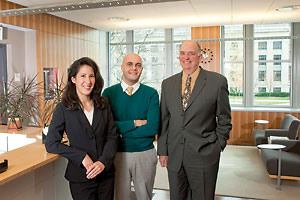The university’s Space Utilization Initiative (SUI), launched in 2007, is helping U-M make better use of its classroom, research and office space and, as a result, saving taxpayer and tuition dollars.

In a progress report last Thursday to the Board of Regents, SUI Project Manager Frances Mueller said, “The SUI is changing the university culture as more units understand and embrace the idea that space is a valuable institutional resource that can and should be shared.”
By making better use of existing space, U-M seeks to minimize the expansion of facilities that are supported by the general fund. The SUI’s ultimate goal is to contain general fund operating costs and reduce the overall environmental impact of campus facilities, Mueller said.
Already, U-M has slowed the rate of general fund building growth. Prior to 2007, building space funded by the general fund (which does not include facilities operated by the U-M Health System, Housing, Intercollegiate Athletics, and Parking and Transportation) had been increasing about 2 percent a year for several years. Since the launch of the SUI, growth in new space has slowed to an average 0.45 percent per year, avoiding approximately $185 million in one-time capital costs and $7.5 million in recurring operating costs that would have been spent had building growth continued at the same pace, Mueller said.
Slowing building growth can have a significant impact on U-M operating costs. New space costs approximately $500 per square foot to construct and $20 per square foot to maintain, Mueller said.
As part of the initiative, U-M has developed:
• A structured process for units to document need and submit requests for major capital projects, creating a transparent and consistent process so the provost and others can review such requests annually and establish institutional priorities.
• Standardized reporting for classroom utilization, research space productivity and energy consumption.
• Campus guidelines for office space and research space allocations.
• A reporting system that shows classroom use by time and day of the week so the provost and deans can identify underused classrooms that can be used for other purposes or may need upgrading.
• Starting with Fall Term 2010 curriculum planning, academic units and the Registrar’s Office will begin sharing classroom-scheduling responsibilities for classes that meet between 8 a.m. and noon. The new, shared scheduling approach will help the Registrar’s Office meet classroom needs campuswide and make better use of U-M space, and faculty, staff and student time.
Mueller cited examples of how U-M is repurposing underused space:
• Older classrooms in the Dennison Building are being transformed into administrative office space for several research institutes.
• The former University Stores building on Varsity Drive now houses multiple research collections, including the herbarium.
• A U-M-owned building on Green Road will house a few units currently leasing space off campus.
• Computer servers previously housed in rooms across campus are now part of U-M’s Virtual Server Initiative, reducing the need for space and energy to cool separate server rooms.
Mueller said those changes alone will reduce lease costs by more than $1 million a year and help the university avoid construction costs in the tens of millions of dollars.
Much of what the SUI has accomplished is due to strong partnerships and the support of U-M units, Mueller said. “Managing space efficiently requires all of us — faculty, students and staff — doing our part,” she said.
For more information about the SUI, go to www.provost.umich.edu/space or e-mail [email protected].

